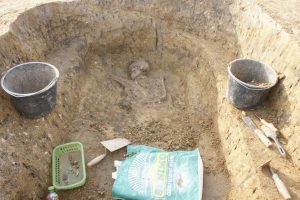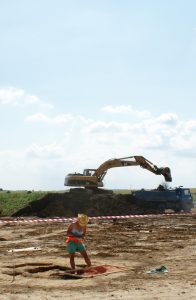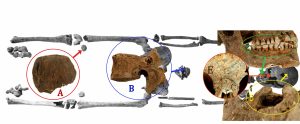01 Oct Anthropological analyses of human bones
Anthropological analyses of human bones consist of a field part and a laboratory part. Field anthropological analyses include evaluation of so-called positional transformations, which enable a reconstruction of primary burial position or at least a detection, whether a body was deposited in a primary hollow space, such as in a coffin, in a chamber or in a niche. Analyses are conducted on a base of data obtained during the field documentation (drawings and photographs). Methods based on a knowledge of taphonomic processes are applied for a reconstruction of a primary burial position, for a detection of a deposition of bodies in hollow spaces and also for a presence of possible secondary interventions. Certain changes in bone positions, caused by a decomposition of joint articulations between neighbouring bones during a corpse decomposition, are characteristic features of space transformations, which depend on a mean of laying of a body in a burial pit and on its possible adjustment. Analysis of position transformation can therefore enable a determination of a primary or secondary burial, a distinguishing of a burial deposited into an open space from a burial with a body immediately covered by soil, and finally it can also help with a reconstruction of the original positions of bodies and their relationships with grave goods and with a grave construction (Černý, 1995; Duday, 2009; Prokeš, 2007).
Laboratory analyses consist of a mechanical drying of bone remains, identification of particular parts of human skeleton, and of a reconstruction of broken bones by gluing them together. A bone preservation degree is estimated by a method calculating a representation of particular bones in an assemblage – BRI (Bone Representation Index). This index presents a degree of a representation of a particular bone in a collection. It is a proportion of an actual number of bones, which were delivered for a laboratory analysis to a total number of bones, which should have been present, if the skeleton was complete (Bello et al., 2006). The bone preservation is further analysed from a quantitative (number of preserved bones) point of view according to Stojanowski, Seidemann and Doran (Stojanowski et al., 2002) and from a qualitative point of view according to Gordon and Buikstra (1981) and Hanáková and Stloukal (1988). A specific type of the preservation analysis presentation is its graphic record.
Anthropological analysis also includes a dental record description. Digitalized form of a record list presents particular observed dental characteristics in a form of a specific numeric record for each particular tooth from all four teeth quadrants. A specific numeric system FDI (Fédération Dentaire Internationale) is used. Each particular tooth is labelled by two digits. A presence of a tooth or a reason of its absence are recorded as well as a presence of caries, hypoplastic changes or tooth calculus. Alveolar resorption rate, presence of pathological apical processes and tooth abrasion are also recorded (Dofková et al., 2015).
Demographic parameters (determination of sex, age and body height) are determined according to internationally standardized methods based on the metrical and morphological characteristics (Stloukal et al., 1999; Schaefer et al., 2009; White, Folkens, 2000). Anthropological analysis of bone remains is followed by a detection of anatomical varieties, so called epigenetic features and by the palaeopathological analysis, which can be in certain cases supplemented by X-ray photographs (Beran, 2012; Fojtová, 2007; Hirt et al., 2011; Horáčková et al., 2004). Metric characteristic of cranial and postcranial skeleton followed by indexing of the measurements enable a reconstruction of physical appearance of a particular analysed individual.
The same spectrum of analyses can be conducted also in a case of burnt bone remains. Analysis of bones remains from cremation burials also consists of an estimation of a cremation temperature (Dokládal, 1982). In a case of secondary deposited bone remains of more individuals (such as in the case of material coming from an ossuary), also another method – Determination of Minimal Number of Individuals (MNI) – can be used.
In the ERCA Centre, the anthropological analyses of bone remains are guaranteed by Mgr. Lukáš Šín, Ph.D., who is an anthropologist employed in the Archaeological Centre in Olomouc.
References
Bello, S.M., Thomann, A., Signoli, M., Dutour, O., Andrews, P., 2006. Age and sex bias in the reconstruction of past population. American Journal of Physical Anthropology 129(1): 24–38.
Beran, M., 2012. Soudnělékařská identifikace. Praha: Univerzita Karlova v Praze.
Černý, V. 1995. Význam tafonomických procesů při studiu pohřebního ritu. Archeologické rozhledy 47: 2: 301–313.
Duday, H., 2009. The Archaeology of the Dead. Oxford: Oxford Books.
Dofková, A., Kováčik, P., Rataj, P., Veselá, P., 2015. Opava Pivovar – Horní dvůr. I, Novověký hřbitov – základní analýza a předběžné shrnutí. Opava: Slezská univerzita v Opavě, Filozoficko-přírodovědecká fakulta v Opavě.
Dokládal, M., 1982. Morfologie spálených kostí. Význam pro identifikaci osob. Brno.
Fojtová, M., 2007. Analýza výskytu epigenetických znaků na kosterních pozůstatcích staroslovanských populací z Dolních Věstonic. Nepublikovaná disertační práce. Brno: Ústav antropologie Přírodovědecké fakulty Masarykovy univerzity.
Gordon, C.G., Buikstra, J.E., 1981. Soil pH, Bone Preservation and Sampling Bias at Mortuary Sites. American Antiquity 46: 566–571.
Hanáková, H., Stloukal, M., 1988. Pohřebiště kolem bývalého kostela sv. Benedikta v Praze. Praha: Národní muzeum.
Hirt, Miroslav et al., 2011. Tupá poranění v soudním lékařství. Praha: Grada.
Horáčková, L., Strouhal, E., Vargová, L., 2004. Základy paleopatologie. In: J. Malina, ed. Panoráma biologické a sociokulturní antropologie 15. Brno: Cerm, Masarykova univerzita v Brně, Nadace Universitas Masarykiana, Nauma.
Prokeš, L., 2007. Posmrtné změny a jejich význam při interpretaci pohřebního ritu (ke vztahu mezi archeologií a forenzními vědami). Archaeologia mediaevalis Moraviana et Silesiana, Supplementum 1. Brno: ÚAM FF MU Brno.
Schaefer, M., Black, S.M., Scheuer, L., 2009. Juvenile osteology: A laboratory and field manual. Amsterdam: Academic.
Stloukal, M., Dobisíková, M., Kuželka, V., Stloukal, M., Stránská, P., Velemínský, P., Vyhnánek, L., Zvára, K., 1999: Antropologie. Příručka pro studium kostry. Praha: Národní muzeum.
Stojanowski, Ch.M., Seidemann, R.M., Doran, G.H., 2002. Differential Skeletal Preservation at Windover Pond: Causes and Consequences. American Journal of Physical Anthropology 119(1): 15–26.

Early Bronze Age grave preparation. Photo by L. Šín.

Documentation of the cremation burial with a use of a documentation frame. Photo by L. Šín.

Spectrum of diseases and epigenetic features determined on a skeleton. Photo by L. Šín.

Reconstruction of a dentition for a dental analysis. Photo by L. Šín.





